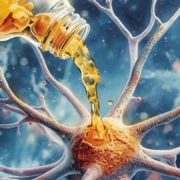The human nervous system orchestrates every aspect of daily life, from the simplest reflex to complex decision-making. At its core, nerve health ensures that signals travel efficiently between the brain and the rest of the body. When nerve health falters, it can lead to a cascade of issues affecting mobility, sensation, and even emotional well-being. Maintaining optimal nerve health requires a multifaceted approach, including proper nutrition, regular monitoring, and timely intervention from a healthcare provider. This foundation supports the intricate network of nerves that keeps the entire body in harmony.
Nerves form the backbone of communication within the body, transmitting electrical impulses at remarkable speeds. These specialized cells, known as nerve cells called neurons, connect in vast networks to relay sensory information and coordinate responses. Sensory nerves relay information about the environment, allowing perception of touch, pain, temperature, sound, taste, smell, and sight. Disruptions in this process, often stemming from injury or chronic conditions, can impair nerve function and lead to discomfort. Understanding the basics of nerve health empowers individuals to take proactive steps toward preservation and recovery.
The Nervous System Framework
The nervous system divides into two primary branches: the central nervous system and the peripheral nervous system. The central nervous system, comprising the brain and spinal cord, serves as the command center for processing information and issuing directives. This core duo integrates inputs from the peripheral nervous system to maintain balance and responsiveness across the body.
In contrast, the peripheral nervous system extends outward, linking the central nervous system to limbs, organs, and sensory organs. Peripheral nerves branch out like tributaries, carrying messages to and from the brain and spinal cord. The chance of nerve regeneration is greater in the peripheral nervous system compared to the central nervous system. This division ensures that the nervous system work remains seamless, allowing for coordinated movement and vital functions such as digestion.
The spinal cord, a vital extension of the brain, runs through the vertebral column and acts as a conduit for neural traffic. Encased in protective bone, it facilitates rapid signal transmission while shielding delicate nerve pathways. Damage to the spinal cord can profoundly impact nerve health, underscoring its role in overall nervous system integrity.
Nerve Cells and Their Role
Nerve cells, or neurons, are the fundamental units of the nervous system. Each neuron consists of a cell body, dendrites for receiving signals, and an axon for sending messages. These cells collaborate to form circuits that govern everything from heartbeat to thought processes. Healthy nerve cells rely on a robust myelin sheath, a fatty layer that insulates axons and accelerates impulse conduction. Foods rich in Vitamin B12, such as fish, eggs, and fortified cereals, are essential for nerve repair.
When the myelin sheath degrades, as in certain nervous system conditions, signals slow or falter, leading to symptoms like weakness or numbness. Protecting nerve cells through targeted nutrients and avoiding toxins is key to supporting nerve health long-term. This cellular resilience forms the bedrock of effective nerve regeneration strategies.
Central Nervous System Dynamics
The central nervous system processes vast amounts of data daily, with the brain at its helm. The brain interprets sensory information from the peripheral nervous system and orchestrates responses via the spinal cord. This interplay ensures that the body adapts to environmental changes swiftly and accurately.
Disorders affecting the central nervous system, such as multiple sclerosis, target the myelin sheath and disrupt signal flow. Early detection through neurological tests can mitigate progression, preserving nerve health. The brain’s plasticity offers hope, as it can rewire pathways to compensate for damaged areas in the nervous system.
Multiple sclerosis exemplifies how inflammation in the central nervous system can erode nerve function over time. Patients often experience slurred speech, muscle weakness, and coordination challenges as symptoms. Managing this condition involves a combination of medications and lifestyle adjustments to bolster the nervous system’s resilience.
Peripheral Nervous System Operations
The peripheral nervous system encompasses all nerves outside the brain and spinal cord, divided into somatic and autonomic divisions. Somatic peripheral nerves control voluntary movements, while autonomic ones regulate involuntary processes like heart rate. This system’s efficiency directly influences nerve health across the entire body.
Peripheral nerves are susceptible to compression or trauma, leading to conditions like carpal tunnel syndrome. In this disorder, a peripheral nerve in the wrist faces undue pressure, causing pain, numbness, and tingling in the hands. Relieving pressure through ergonomic changes or supportive devices can alleviate these issues.
Peripheral neuropathy represents a broad category of nerve damage affecting peripheral nerves. It often manifests as burning pain or loss of sensation in the extremities. Addressing underlying causes, such as poor circulation or vitamin deficiencies, is crucial for managing peripheral neuropathy and supporting nerve health.
Spinal Cord Protection Strategies
The spinal cord demands vigilant care due to its vulnerability to injury. Trauma from accidents or degenerative changes can sever connections between the brain and peripheral nerves, resulting in paralysis or chronic pain. Strengthening surrounding muscles through targeted exercises enhances spinal cord stability.
In cases of spinal cord compression, surgery may be necessary to decompress nerves and restore flow. Post-operative rehabilitation focuses on nerve regeneration, gradually rebuilding strength and sensation. Consistent monitoring by a healthcare provider ensures optimal recovery for the nervous system.
Beyond physical safeguards, nutritional support aids spinal cord health. Antioxidants from berries and omega-3s from fish help combat inflammation, potentially shielding nerve cells from oxidative stress. Magnesium and potassium regulate nerve impulses and are found in leafy greens, nuts, seeds, and avocados. Integrating these elements promotes healthier nerves and sustained nervous system function.
Symptoms of Nerve Problems
Symptoms of nerve problems vary widely but often signal underlying disruptions in the nervous system. Common indicators include numbness, tingling, and weakness, particularly in the arms or legs. These sensations arise when damaged nerves fail to transmit sensory information effectively to the brain.
Nerve pain, another hallmark, can range from sharp stabs to dull aches, interfering with daily activities. Muscle weakness accompanies many nerve issues, making tasks like gripping objects challenging. In severe cases, slurred speech or balance difficulties point to central nervous system involvement.
Tingling often precedes more persistent numbness, serving as an early warning for nerve damage. If left unaddressed, these symptoms can escalate into complications like infections or falls. Prompt evaluation by a healthcare provider is essential to identify the root cause and initiate appropriate treatment.
Numbness and Its Implications
Numbness occurs when nerves lose their ability to send messages about touch or temperature, creating a “pins and needles” void. This symptom frequently affects the extremities due to peripheral nerve compression or systemic issues like diabetes. Chronic numbness heightens the risk of unnoticed injuries, as the skin becomes less responsive.
In the context of neuropathy, numbness signals progressive nerve damage that demands attention. Diabetics, in particular, face elevated risks, with high blood sugar eroding peripheral nerves over time. Monitoring blood sugar levels proves vital in preventing further deterioration of nerve health.
Addressing numbness involves a dual approach: alleviating immediate discomfort and tackling causative factors. Over-the-counter aids and gentle massage can temporarily restore sensation, while long-term strategies focus on enhancing blood circulation to affected areas.
Tingling Sensations Decoded
Tingling, often described as electric prickling, stems from irritated or inflamed nerves firing erratically. This symptom commonly arises from temporary pressure on a peripheral nerve, such as prolonged sitting, but persists in chronic nerve conditions. It serves as the body’s alert to potential nerve damage.
For individuals with diabetes, tingling in the feet or hands indicates early neuropathy, where elevated blood sugar impairs nerve cells. Early intervention through glycemic control can halt progression, preserving nerve function. Lifestyle tweaks, like regular physical activity, further mitigate tingling by improving oxygen delivery to nerves.
When tingling accompanies weakness or pain, it may herald more serious nervous system disorders. Diagnostic tests, including nerve conduction studies, help pinpoint the issue. Tailored treatments then aim to soothe inflamed nerves and restore normal signaling.
Muscle Weakness in Nerve Contexts
Muscle weakness emerges when motor nerves fail to stimulate muscles adequately, leading to reduced strength and coordination. This symptom disrupts movement, from walking to fine motor tasks, and often links to spinal cord or peripheral nerve injuries. Early recognition allows for interventions that prevent atrophy.
In multiple sclerosis, immune-mediated attacks on the myelin sheath cause fluctuating weakness, affecting daily life profoundly. Physical therapy plays a pivotal role here, rebuilding muscle-nerve connections through guided exercises. Consistent practice fosters nerve regeneration and enhances overall nervous system work.
Diabetes accelerates muscle weakness via neuropathy, where damaged peripheral nerves weaken signals to leg muscles. Managing this involves blood sugar control alongside strength training. Such measures not only alleviate weakness but also support broader nerve health initiatives.
Pain Management in Nerve Health
Pain from nerve issues, known as neuropathic pain, differs from typical inflammatory discomfort by its shooting or burning quality. It arises when damaged nerves misfire, overwhelming the brain with erroneous signals. Effective management requires a nuanced understanding of these pathways.
Medications targeting nerve pain, such as gabapentin, modulate aberrant signals without broadly suppressing the nervous system. For milder cases, topical treatments provide localized relief, minimizing systemic side effects. Always consult a healthcare provider before starting any regimen to ensure safety.
Chronic nerve pain can erode quality of life, prompting exploration of adjunct therapies like acupuncture. These methods may reduce inflammation around affected nerves, promoting healing. Integrating pain control with nerve-supportive nutrients yields comprehensive benefits for the entire body.
Risk Factors for Nerve Damage
Several risk factors heighten vulnerability to nerve damage, with diabetes topping the list due to its direct impact on nerve cells. Prolonged high blood sugar fosters oxidative stress, degrading the myelin sheath and impairing peripheral nerves. Controlling diabetes through diet and medication significantly lowers this risk.
Injuries rank as another major contributor, from acute trauma like falls to repetitive strain in occupations. Such events compress or sever nerves, leading to immediate or delayed symptoms. Protective gear and ergonomic practices mitigate these threats to nerve health.
Infections and autoimmune disorders, including other causes like Lyme disease, inflame nerves and disrupt their function. Genetic predispositions also play a role, making some individuals more prone to neuropathy. Routine health screenings help identify and address these risks proactively.
Diabetes and Its Toll on Nerves
Diabetes profoundly influences nerve health, with up to half of patients developing neuropathy over time. Elevated blood sugar damages small blood vessels supplying nerves, starving them of oxygen and nutrients. This process, termed diabetic neuropathy, predominantly affects peripheral nerves in the feet and hands.
Symptoms in diabetic neuropathy include numbness, tingling, and severe pain, progressing silently until complications arise. Foot ulcers, a dire outcome, stem from unnoticed injuries due to sensory loss. Vigilant foot care and regular check-ups with a healthcare provider are non-negotiable for diabetics.
Preventing diabetic nerve damage hinges on glycemic control, achieved via balanced meals and exercise. Medications like metformin aid in stabilizing blood sugar, indirectly supporting nerve regeneration. For those already affected, alpha lipoic acid supplementation shows promise in reducing oxidative stress on nerves.
Alpha lipoic acid, a potent antioxidant, combats the inflammation fueling diabetic neuropathy. Studies indicate it may enhance nerve conduction and alleviate pain, making it a valuable adjunct. Doses typically range from 600-1200 mg daily, but healthcare provider guidance is essential to avoid interactions.
Injuries Impacting the Nervous System
Injuries to nerves often result from blunt force or surgical mishaps, disrupting the flow of messages throughout the body. Spinal cord injuries, for instance, can cause immediate paralysis by severing connections to peripheral nerves. Rehabilitation focuses on maximizing residual function through innovative therapies.
Peripheral nerve injuries, common in sports or accidents, lead to localized pain and weakness. Surgical repair, involving nerve grafts, aims to bridge gaps and promote regeneration. Recovery timelines vary, with younger patients often experiencing better outcomes due to robust cellular repair mechanisms.
Post-injury inflammation exacerbates nerve damage, prolonging healing. Anti-inflammatory agents and cold therapy help control swelling, allowing nerves to mend. Long-term, adaptive strategies ensure that individuals regain independence despite lingering effects on the nervous system.
Other Causes of Nerve Issues
Beyond diabetes and injury, toxins like heavy metals or chemotherapy agents pose risks to nerve health. These substances accumulate, poisoning nerve cells and myelin sheaths. Chelation therapy or drug adjustments can reverse some effects, restoring partial function.
Nutritional deficiencies, particularly in B vitamins, contribute to neuropathy by impairing nerve maintenance. Alcohol excess mimics this by depleting thiamine, leading to Wernicke’s encephalopathy with slurred speech and ataxia. Abstinence and supplementation address these reversible causes effectively.
Autoimmune attacks, as in Guillain-Barré syndrome, trigger rapid nerve damage following infections. Intravenous immunoglobulins treat this by neutralizing errant antibodies, halting progression. Awareness of these triggers enables swift action to protect the nervous system.
Supporting Nerve Health Nutritionally
Nutrition stands as a cornerstone in supporting nerve health, with specific vitamins fortifying nerve cells against wear. B vitamins, especially B12 and B6, aid in myelin production and neurotransmitter synthesis. Incorporating leafy greens and fortified cereals ensures adequate intake for optimal nerve function.
Omega-3 fatty acids from sources like salmon reduce inflammation, safeguarding peripheral nerves from damage. Regular consumption may enhance blood circulation, delivering vital oxygen to nerve tissues. This nutrient synergy promotes healthier nerves and mitigates neuropathy risks.
Antioxidants, including vitamin E from nuts, neutralize free radicals that harm the nervous system. A diet rich in these compounds supports nerve regeneration, particularly in aging populations. Balancing macronutrients alongside these vitamins creates a robust defense for the entire body.
Vitamins Crucial for Nerves
Vitamin B12 deficiency directly correlates with nerve damage, causing demyelination and sensory loss. Found in dairy products and meats, it facilitates red blood cell formation, ensuring nerve oxygenation. Supplementation benefits vegans or those with absorption issues, under medical supervision.
Folate, or vitamin B9, works in tandem with B12 to prevent homocysteine buildup, a neurotoxin. Leafy vegetables provide ample folate, supporting DNA repair in nerve cells. Deficiencies heighten stroke risk, indirectly threatening brain and spinal cord integrity.
Vitamin D, synthesized via sunlight or supplements, modulates immune responses to curb inflammation in nerves. Low levels link to multiple sclerosis flares, emphasizing its role in central nervous system protection. Routine testing guides supplementation for nerve health maintenance.
Alpha lipoic acid extends beyond diabetes management, potentially aiding other neuropathies by recycling antioxidants like vitamins C and E. Its dual water- and fat-soluble nature allows deep penetration into nerve tissues. Clinical trials support its use for reducing pain and improving conduction.
Seven Foods That May Aid Nerve Repair
Certain foods offer compounds that may support nerve repair by nourishing cells and reducing oxidative stress. Walnuts, packed with alpha lipoic acid and omega-3s, combat inflammation in damaged nerves. A handful daily could enhance peripheral nerve recovery.
Broccoli, rich in vitamin B6 and sulforaphane, promotes myelin sheath integrity. This cruciferous vegetable aids detoxification, shielding nerves from toxins. Steaming preserves nutrients, making it an accessible choice for daily nerve health support.
Salmon provides DHA, an omega-3 essential for neuron membrane fluidity. Regular intake may alleviate nerve pain and foster regeneration in the spinal cord. Grilling maintains its benefits without added fats.
Avocados deliver vitamin E and potassium, bolstering nerve signal transmission. Their monounsaturated fats improve blood circulation to extremities, countering numbness from poor circulation.
Eggs supply choline, a precursor to acetylcholine, vital for nerve-muscle communication. This nutrient helps repair damaged peripheral nerves, reducing weakness.
Blueberries, laden with anthocyanins, protect against age-related nerve decline. Their antioxidants may enhance brain-derived neurotrophic factor, aiding nerve regeneration.
Spinach offers magnesium and folate, crucial for energy production in nerve cells. It supports the nervous system’s electrical activity, potentially easing tingling sensations.
Lifestyle Approaches to Nerve Healing
Healing nerves demands patience, as regeneration proceeds at a glacial pace of about one millimeter per day. Consistent strategies, like avoiding smoking, preserve vascular health and oxygen supply to nerves. This simple shift profoundly impacts long-term nerve health.
Regular physical activity stimulates endorphin release, naturally dulling nerve pain while strengthening supporting muscles. Low-impact options like swimming minimize injury risk, promoting safe nervous system work. Regular aerobic exercise enhances blood flow to the brain and nourishes nerve cells, further supporting overall nerve health.
Stress management techniques, such as mindfulness, lower cortisol levels that exacerbate inflammation. Chronic stress impairs nerve repair, so integrating relaxation practices supports holistic recovery.
How to Heal Nerves Effectively
To heal nerves, prioritize addressing the underlying cause, whether diabetes control or injury rehabilitation. Medications and surgery treat acute damage, while nutrients fuel cellular repair. A healthcare provider tailors plans to individual needs, optimizing outcomes.
Physical therapy accelerates healing by retraining neural pathways, enhancing movement and reducing pain. Customized exercises rebuild strength without overloading recovering nerves.
Patience remains key, as full recovery may span months. Tracking progress through symptom journals informs adjustments, ensuring steady advancement in nerve health.
Restoring the Nervous System Balance
Restoring the nervous system involves holistic measures that extend beyond isolated fixes. Balancing the autonomic branches through yoga harmonizes fight-or-flight responses with restful states, easing nerve strain.
Nutritional replenishment, focusing on anti-inflammatory diets, rebuilds depleted stores in nerve cells. Hydration supports electrolyte balance, essential for impulse conduction across the body.
Sleep hygiene proves indispensable, as deep rest phases consolidate neural repairs. Aim for seven to nine hours nightly to bolster brain and spinal cord recovery.
Diagnostic tests, like MRIs, monitor restoration, guiding interventions for complications. Collaborative care with specialists ensures comprehensive nervous system revival.
Medical Interventions for Neuropathy
Medications form the frontline in treating neuropathy, with anticonvulsants like pregabalin dampening hyperexcitable nerves. These agents reduce pain without sedation, allowing functional daily life.
Surgery addresses structural causes, such as relieving pressure on compressed peripheral nerves. Microscopic techniques minimize trauma, hastening return to normal nerve function.
Emerging therapies, including stem cell injections, hold potential for nerve regeneration. They deliver progenitor cells to damaged sites, encouraging tissue regrowth. Ongoing research refines these for broader application.
Physical Therapy’s Role in Recovery
Physical therapy rebuilds nerve-muscle interfaces through progressive loading, countering weakness from disuse. Therapists employ modalities like electrical stimulation to jumpstart dormant nerves.
Tailored programs incorporate balance training, vital for preventing falls in neuropathy patients. This approach not only restores movement but also boosts confidence in nervous system capabilities.
Home extensions of therapy, such as resistance bands, sustain gains between sessions. Consistency amplifies benefits, fostering healthier nerves over time.
Consulting Healthcare Providers Timely
Engaging a healthcare provider early transforms nerve health trajectories. They conduct comprehensive assessments, from blood work to electromyography, unmasking hidden issues.
Personalized plans integrate treatments with preventive advice, mitigating risks like diabetes progression. Follow-ups track efficacy, adjusting as the nervous system evolves.
Empowerment through education equips patients to advocate for their care, ensuring aligned interventions for optimal nerve health.
Preventing Nervous System Disorders
Prevention of nervous system disorders begins with modifiable risks, like maintaining ideal weight to shield against diabetes. Routine screenings catch subclinical changes, averting full-blown neuropathy.
Vaccinations curb infection-related nerve damage, while protective lifestyles guard against injuries. These proactive steps safeguard the brain, spinal cord, and peripheral nerves alike.
Community resources, including support groups, reinforce adherence to preventive regimens. Collective knowledge amplifies individual efforts toward enduring nerve health.
Complications from Untreated Nerve Issues
Untreated nerve damage invites complications, from chronic pain to autonomic dysfunction affecting digestion. Infections thrive in numb areas, escalating to systemic threats.
Mobility loss heightens fall risks, compounding injuries to the spinal cord. Vascular issues from poor circulation further imperil nerve tissues, creating vicious cycles.
Early treatment disrupts these paths, preserving quality of life and nervous system vitality.
Unique Perspectives on Nerve Resilience
Nerve resilience varies genetically, with some individuals exhibiting superior repair capacities post-injury. Epigenetic factors, influenced by diet, modulate this trait, offering levers for enhancement.
Microbiome health indirectly bolsters nerves via gut-brain axis signaling, where diverse flora reduces inflammation. Fermented foods may thus support peripheral nerve integrity.
Emerging evidence links intermittent fasting to heightened neurotrophic factors, potentially accelerating myelin repair. This metabolic strategy warrants cautious exploration under supervision.
Integrating Nutrients for Lasting Health
Synthesizing nutrients for nerve health requires synergy, as isolated vitamins yield limited results. B-complex formulations ensure balanced delivery, supporting methylation pathways in cells.
Hydration amplifies nutrient transport, flushing toxins that burden the nervous system. Herbal allies like turmeric, with curcumin, complement vitamins by curbing inflammation.
Tracking intake via apps personalizes regimens, aligning with bodily responses for sustained nerve protection.
Final Thoughts on Nerve Vitality
Prioritizing nerve health yields dividends in vitality and autonomy, as a robust nervous system underpins every endeavor. From diabetes vigilance to nutrient-rich plates, deliberate actions fortify this vital network.
Embracing a spectrum of strategies—from medical oversight to mindful movement—cultivates resilience against inevitable stresses. In doing so, individuals not only mend but thrive, embodying the profound adaptability of human nerves.







